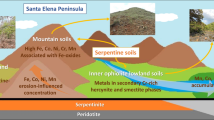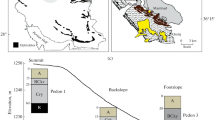Abstract
This study aimed at relating the variability of Ni biogeochemistry along the ultramafic toposequence to pedogenesis and soil mineralogy. Hypereutric Cambisols dominate upslope; Cambic Vertisols and Fluvic Cambisols occur downslope. The soil mineralogy showed abundance of primary serpentine all over the sequence. It is predominant upslope but secondary smectites dominate in the Vertisols. Free Fe-oxides are abundant in all soils but slightly more abundant in the upslope soils. Whereas serpentines hold Ni in a similar and restricted range in every soil (approx. 0.3 %), Ni contents in smectites may vary a lot and Mg-rich and Al-poor smectites in the Vertisol could hold up to 4.9 % Ni. Ni was probably adsorbed onto amorphous Fe-oxides and was also exchangeable in secondary smectites. High availability of Ni in soils was confirmed by DTPA extractions. However, it varied significantly along the toposequence, being higher in upslope soils, where Ni-bearing amorphous Fe-oxides were abundant and total organic carbon higher and sensibly lower downslope on the Vertisols: NiDTPA varied from 285 mg kg−1 in the surface of soil I (upslope) to 95.9 mg kg−1 in the surface of Fluvic Cambisols. Concentration of Ni in Alyssum murale shoots varied from 0.7 % (Hypereutric Cambisols) to 1.4 % (Hypereutric Vertisol). Amazingly, Ni uptake by A. murale was not correlated to NiDTPA, suggesting the existence of specific edaphic conditions that affect the ecophysiology of A. murale upslope.


Similar content being viewed by others
References
AFNOR. (2004). Evaluation de la qualité des Sols (Vol. 1 & 2). France: AFNOR, Saint-Denis. 461pp & 486 pp.
Alexander, E. B. (2004). Serpentine soil redness, differences among peridotite and serpentinite materials, Klamath Mountains. California. International Geology Review, 46, 754–764.
Antic-Mladenovic, S., Rinklebe, J., Frohne, T., Stärk, H.-J., Wennrich, R., Tomic, Z., et al. (2011). Impact of controlled redox conditions on nickel in a serpentine soil. Journal Soils and Sediments, 11, 406–415.
Bani, A., Echevarria, G., Sulçe, S., Morel, J. L., & Mullai, A. (2007). In-situ phytoextraction of Ni by a native population of Alyssum murale on an ultramafic site (Albania). Plant and Soil, 293, 79–89.
Bani, A., Echevarria, G., Mullaj, A., Reeves, R., Morel, J. L., & Sulçe, S. (2009). Ni hyperaccumulation by Brassicaceae in serpentine soils of Albania and NW Greece. Northeastern Naturalist, 16, 385–404.
Bani A., Echevarria G., Sulçe S., Morel J.L. (2014) Improving the agronomy of Alyssum murale for extensive phytomining: A five-year field study. Int J Phytoremediation.
Becquer, T., Quantin, C., Rotte-Capet, S., Ghanbaja, J., Mustin, C., & Herbillon, A. J. (2006). Sources of trace metals in ferralsols in New Caledonia. European Journal of Soil Science, 57, 200–213.
Bonifacio, E., & Barberis, E. (1999). Phosphorus dynamics during pedogenesis on serpentinite. Soil Science, 164, 960–968.
Bonifacio, E., Zanini, E., Boero, V., & Franchini-Angela, M. (1997). Pedogenesis in a soil catena on serpentinite in north-western Italy. Geoderma, 75, 33–51.
Brooks, R.R. (1987). Serpentine and Its Vegetation, Dudley, T.R. (Ed.), Discorides, Portland, OR. 454 pp.
Caillaud, J., Proust, D., Righi, D., & Martin, F. (2004). Fe-rich clays in a weathering profile developed from serpentinite. Clays and Clay Minerals, 52, 779–791.
Caillaud, J., Proust, D., Philippe, S., Fontaine, C., & Fialin, M. (2009). Trace metals distribution from a serpentinite weathering at the scales of the weathering profile and its related weathering microsystems and clay minerals. Geoderma, 149, 199–208.
Chaney, R. L., Angle, J. S., Broadhurst, C. L., Peters, C. A., Tappero, R. V., & Sparks, D. L. (2007). Improved understanding of hyperaccumulation yields commercial phytoextraction and phytomining technologies. Journal of Environmental Quality, 36, 1429.
Chardot, V., Massoura, S. T., Echevarria, G., Reeves, R. D., & Morel, J. L. (2005). Phytoextraction potential of the nickel hyperaccumulators Leptoplax emarginata and Bornmuellera tymphaea. International Journal of Phytoremediation, 7, 323–335.
Chardot, V., Echevarria, G., Gury, M., Massoura, S., & Morel, J. L. (2007). Nickel bioavailability in an ultramafic toposequence in the Vosges Mountains (France). Plant and Soil, 293, 7–21.
Cheng, C. H., Jien, S. H., Iizuka, Y., Tsai, H., Chang, Y. H., & Hseu, Z. Y. (2011). Pedogenic chromium and nickel partitioning in serpentine soils along a toposequence. Soil Science Society of America Journal, 75, 659–668.
Coleman, R. G., & Jove, C. (1991). Geological origin of serpentinites. In A. J. M. Baker (Ed.), The vegetation of ultramafic (serpentine) soils: proceedings of the first international conference on serpentine ecology (pp. 1–17). Andover, Hampshire, UK: Intercept.
D’Amico, M. E., & Previtali, F. (2012). Edaphic influences of ophiolitic substrates on vegetation in the Western Italian Alps. Plant and Soil. doi:10.1007/s11104-011-0932-6.
Dilek, Y., & Furnes, H. (2009). Structure and geochemistry of Tethyan ophiolites and their petrogenesis in subduction rollback systems. Lithos, 113, 1–20.
Ece, O. I., Coban, F., Gungor, N., & Suner, F. (1999). Clay mineralogy and occurrence of ferrian smectites between serpentinite saprolites and basalts in biga peninsula, northwest turkey. Clays and Clay Minerals, 47, 241–251.
Echevarria, G., Morel, J. L., Fardeau, J. C., & Leclerc-Cessac, E. (1998). Assessment of phytoavailability of nickel in soils. Journal of Environmental Quality, 27, 1064–1070.
Echevarria, G., Massoura, S. T., Sterckeman, T., Becquer, T., Schwartz, C., & Morel, J. L. (2006). Assessment and control of the bioavailability of nickel in soils. Environmental Toxicology and Chemistry, 25 (3), 643–651.
Garnier, J., Quantin, C., Echevarria, G., & Becquer, T. (2009). Assessing chromate availability in tropical ultramafic soils using isotopic exchange kinetics. Journal Soils and Sediments, 9, 468–475.
Gjoka, F., Felix-Henningsen, P., Wegener, H.-R., Salillari, I., & Beqiraj, A. (2011). Heavy metals in soils from Tirana (Albania). Environmental Monitoring and Assessment, 172, 517–527.
Istok, J. D., & Harward, M. D. (1982). Influence of soil moisture on smectite formation in soils derived from serpentinite. Soil Science Society of America Journal, 46, 1106–1108.
IUSS Working Group WRB. (2006). World reference base for soil resources, world soil resources reports (103). Rome: FAO.
Jaffré, T., Brooks, R. R., Lee, J., & Reeves, R. D. (1976). Sebertia acuminata: a hyperaccumulator of nickel from New Caledonia. Science, 193, 579–580.
Kierczak, J., Néel, C., Bril, H., & Puziewicz, J. (2007). Effect of mineralogy and pedoclimatic variations on Ni and Cr distribution in serpentine soils under temperate climate. Geoderma, 142, 165–177.
Lee, B. D., Graham, R. C., Laurent, T. E., Amrhein, C., & Creasy, R. M. (2001). Spatial distributions of soil chemical conditions in a serpentinitic wetland and surrounding landscape. Soil Science Society of America Journal, 65, 1183–1196.
Lee, B. D., Sears, S. K., Graham, R. C., Amrhein, C., & Vali, H. (2003). Secondary mineral genesis from chlorite and serpentine in an ultramafic soil toposequence. Soil Science Society of America Journal, 67, 1309–1317.
Lee, B. D., Graham, R. C., Laurent, T. E., & Amrhein, C. (2004). Pedogenesis in a wetland meadow and surrounding serpentinitic landslide terrain, northern California, USA. Geoderma, 118 (3–4), 303–320.
Lindsay, W. L., & Norvell, W. A. (1978). Development of DTPA soil test for zinc, iron, manganese, and copper. Soil Science Society of America Journal, 42, 421–428.
Manika, K. (1994). Pétrologie du massif ophiolitique de Shebenik (Albanie). PhD Dissertation, Université de Paris-Sud Orsay (in French).
Massoura, S. T., Echevarria, G., Leclerc-Cessac, E., & Morel, J. L. (2004). Response of excluder, indicator and hyperaccumulator plants to nickel availability in soils. Aust. J. Soil Research, 42, 933–938.
Massoura, S. T., Echevarria, G., Becquer, T., Ghanbaja, J., Leclerc-Cessac, E., & Morel, J. L. (2006). Nickel bearing phases and availability in natural and anthropogenic soils. Geoderma, 136, 28–37.
McCahon, T. J., & Munn, L. C. (1991). Soils developed in late Pleistocene till, medicine Bow mountains. Wyoming Soil Science, 152, 377–388.
McKeague, J. J., & Day, J. A. (1966). Dithionite and oxalate extractable Fe and Al as aids in differentiating different classes of soils. Canadian Journal of Soil Science, 46, 13–22.
Mehra, O. P., & Jackson, M. L. (1960). Iron oxides removal from soils and clays by dithionite-citrate systems buffered with sodium bicarbonate. In A. Swineford (Ed.), Proceedings of the 7th Nat (pp. 317–342). Elmsdorf, NY: Conf. Clay Minerals. Pergamon Press.
O’Hanley, D. S. (1996). Serpentinites: records of tectonic and petrological history. In Oxford monographs on geology and geophysics. New York: Oxford University Press. 277 pp.
Proctor, J., & Woodell, S. R. J. (1975). The ecology of serpentine soils. Advances in Ecological Research, 9, 255–365.
Raous, S., Echevarria, G., Sterckeman, T., Hanna, K., Thomas, F., Martins, E. S., et al. (2013). Potentially toxic metals in ultramafic mining materials: identification of the main bearing and reactive phases. Geoderma, 192, 111–119.
Tang, Y. T., Deng, T. H. B., Wu, Q. H., Qiu, R. L., Wei, Z. B., Guo, X. F., et al. (2012). Designing cropping systems adapted to metal contaminated sites: a review. Pedosphere, 22, 470–488.
World Reference Base for soil resources (2006) World Soil Resources Reports No. 103. FAO, Rome.
Whittaker, R. H. (1954). The ecology of serpentine soils: a symposium. I. Introduction. Ecological, 35, 258–259.
Zdruli, P. (1997). Benchmark Soils of Albania: Resource Assessment for Sustainable Land Use. PhD. thesis. Published by the USDA Natural Resources Conservation Service (NRCS), Washington DC and the International Fertilizer Development Center (IFDC), Muscle Shoals, AL. 2 Volumes. pp. 293.
Acknowledgments
This work was supported by the French Embassy in Tirana who provided a grant to Prof. Aida Bani for her PhD and by the French National Research Agency through the national “Investissements d’avenir” programme, reference ANR-10-LABX-21 (LABEX RESSOURCES21).
Author information
Authors and Affiliations
Corresponding author
Rights and permissions
About this article
Cite this article
Bani, A., Echevarria, G., Montargès-Pelletier, E. et al. Pedogenesis and nickel biogeochemistry in a typical Albanian ultramafic toposequence. Environ Monit Assess 186, 4431–4442 (2014). https://doi.org/10.1007/s10661-014-3709-6
Received:
Accepted:
Published:
Issue Date:
DOI: https://doi.org/10.1007/s10661-014-3709-6




